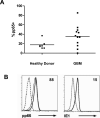Glioma-associated cytomegalovirus mediates subversion of the monocyte lineage to a tumor propagating phenotype
- PMID: 21490182
- PMCID: PMC3139801
- DOI: 10.1158/1078-0432.CCR-11-0414
Glioma-associated cytomegalovirus mediates subversion of the monocyte lineage to a tumor propagating phenotype
Abstract
Purpose: Cytomegalovirus (CMV) has been ubiquitously detected within high-grade gliomas, but its role in gliomagenesis has not been fully elicited.
Experimental design: Glioblastoma multiforme (GBM) tumors were analyzed by flow cytometry to determine CMV antigen expression within various glioma-associated immune populations. The glioma cancer stem cell (gCSC) CMV interleukin (IL)-10 production was determined by ELISA. Human monocytes were stimulated with recombinant CMV IL-10 and levels of expression of p-STAT3, VEGF (vascular endothelial growth factor), TGF-β, viral IE1, and pp65 were determined by flow cytometry. The influence of CMV IL-10-treated monocytes on gCSC biology was ascertained by functional assays.
Results: CMV showed a tropism for macrophages (MΦ)/microglia and CD133+ gCSCs within GBMs. The gCSCs produce CMV IL-10, which induces human monocytes (the precursor to the central nervous system MΦs/microglia) to assume an M2 immunosuppressive phenotype (as manifested by downmodulation of the major histocompatibility complex and costimulatory molecules) while upregulating immunoinhibitory B7-H1. CMV IL-10 also induces expression of viral IE1, a modulator of viral replication and transcription in the monocytes. Finally, the CMV IL-10-treated monocytes produced angiogenic VEGF, immunosuppressive TGF-β, and enhanced migration of gCSCs.
Conclusions: CMV triggers a feedforward mechanism of gliomagenesis by inducing tumor-supportive monocytes.
Figures






Comment in
-
Is cytomegalovirus a therapeutic target in glioblastoma?Clin Cancer Res. 2011 Jul 15;17(14):4619-21. doi: 10.1158/1078-0432.CCR-11-0992. Epub 2011 Jun 1. Clin Cancer Res. 2011. PMID: 21632859
Similar articles
-
Glioma cancer stem cells induce immunosuppressive macrophages/microglia.Neuro Oncol. 2010 Nov;12(11):1113-25. doi: 10.1093/neuonc/noq082. Epub 2010 Jul 28. Neuro Oncol. 2010. PMID: 20667896 Free PMC article.
-
Is cytomegalovirus a therapeutic target in glioblastoma?Clin Cancer Res. 2011 Jul 15;17(14):4619-21. doi: 10.1158/1078-0432.CCR-11-0992. Epub 2011 Jun 1. Clin Cancer Res. 2011. PMID: 21632859
-
The detection of CMV pp65 and IE1 in glioblastoma multiforme.J Neurooncol. 2011 Jun;103(2):231-8. doi: 10.1007/s11060-010-0383-6. Epub 2010 Sep 5. J Neurooncol. 2011. PMID: 20820869
-
Cytomegalovirus as an oncomodulatory agent in the progression of glioma.Cancer Lett. 2017 Jan 1;384:79-85. doi: 10.1016/j.canlet.2016.10.022. Epub 2016 Oct 21. Cancer Lett. 2017. PMID: 27777041 Review.
-
Human cytomegalovirus-mediated immunomodulation: Effects on glioblastoma progression.Biochim Biophys Acta Rev Cancer. 2017 Aug;1868(1):273-276. doi: 10.1016/j.bbcan.2017.05.006. Epub 2017 May 26. Biochim Biophys Acta Rev Cancer. 2017. PMID: 28554666 Review.
Cited by
-
Disruption of Bcl-2 and Bcl-xL by viral proteins as a possible cause of cancer.Infect Agent Cancer. 2014 Dec 23;9:44. doi: 10.1186/1750-9378-9-44. eCollection 2014. Infect Agent Cancer. 2014. PMID: 25699089 Free PMC article. Review.
-
Genetic analysis of cytomegalovirus in malignant gliomas.J Virol. 2012 Jun;86(12):6815-24. doi: 10.1128/JVI.00015-12. Epub 2012 Apr 11. J Virol. 2012. PMID: 22496213 Free PMC article.
-
The immune checkpoint protein PD-L1 induces and maintains regulatory T cells in glioblastoma.Oncoimmunology. 2018 Apr 25;7(7):e1448329. doi: 10.1080/2162402X.2018.1448329. eCollection 2018. Oncoimmunology. 2018. PMID: 29900065 Free PMC article.
-
Severe adverse immunologic reaction in a patient with glioblastoma receiving autologous dendritic cell vaccines combined with GM-CSF and dose-intensified temozolomide.Cancer Immunol Res. 2015 Apr;3(4):320-5. doi: 10.1158/2326-6066.CIR-14-0100. Epub 2014 Nov 11. Cancer Immunol Res. 2015. PMID: 25387895 Free PMC article.
-
Accelerated cancer aggressiveness by viral oncomodulation: New targets and newer natural treatments for cancer control and treatment.Surg Neurol Int. 2019 Oct 11;10:199. doi: 10.25259/SNI_361_2019. eCollection 2019. Surg Neurol Int. 2019. PMID: 31768279 Free PMC article. Review.
References
-
- Demmler GJ. What is CMV? 2010 [webpage] [cited; Available from: www.congenitalcmv.org/public.htm.
-
- Cobbs C, Harkins L, Samanta M, et al. Human cytomegalovirus infection and expression in human malignant glioma. Cancer Res. 2002;62:3347–50. - PubMed
-
- Mitchell DA, Archer G, Bigner D, et al. RNA-loaded dendritic cells targeting cytomegalovirus in patients with malignant glioma. Neuro Oncol. 2007;9:509.
Publication types
MeSH terms
Substances
Grants and funding
LinkOut - more resources
Full Text Sources
Other Literature Sources
Medical
Research Materials
Miscellaneous

